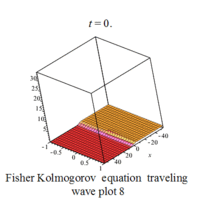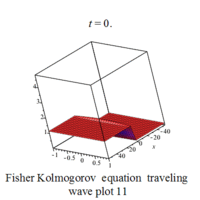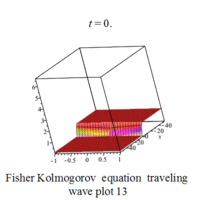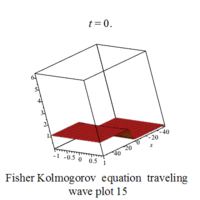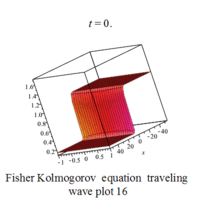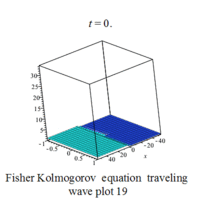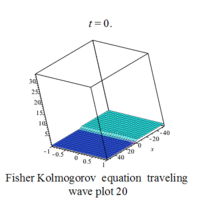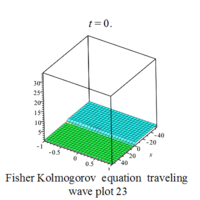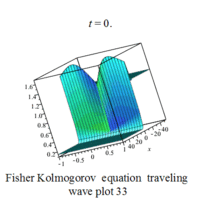Fisher's equation
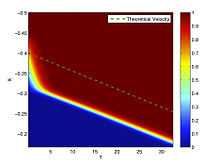
Numerical simulation of the Fisher–KPP equation. In colors: the solution u(t,x); in dots : slope corresponding to the theoretical velocity of the traveling wave.
In mathematics, Fisher's equation, named after R. A. Fisher,[1] is the partial differential equation

Fisher proposed this equation[2] to describe the spatial spread of an advantageous allele and explored its travelling wave solutions. For every wave speed  (
( in dimensionless form) it admits travelling wave solutions of the form
in dimensionless form) it admits travelling wave solutions of the form

where  is increasing and
is increasing and

That is, the solution switches from the equilibrium state u = 0 to the equilibrium state u = 1. No such solution exists for c < 2.[2][3][4] The wave shape for a given wave speed is unique. The travelling-wave solutions are stable against near-field perturbations, but not to far-field perturbations which can thicken the tail. One can prove using the comparison principle and super-solution theory that all solutions with compact initial data converge to waves with the minimum speed.
For the special wave speed  , all solutions can be found in a closed form,[5] with
, all solutions can be found in a closed form,[5] with

where  is arbitrary, and the above limit conditions are satisfied for
is arbitrary, and the above limit conditions are satisfied for  .
.
It is perhaps the simplest example of a semilinear reaction-diffusion equation

which can exhibit traveling wave solutions that switch between equilibrium states given by  . Such equations occur, e.g., in ecology, physiology, combustion, crystallization, plasma physics, and in general phase transition problems.
. Such equations occur, e.g., in ecology, physiology, combustion, crystallization, plasma physics, and in general phase transition problems.
Proof of the existence of traveling wave solutions and analysis of their properties is often done by the phase space method.
Traveling wave solutions
See also
References
- ↑ Fisher, R. A., The genetical theory of natural selection. Oxford University Press, 1930. Oxford University Press, USA, New Ed edition, 2000, ISBN 978-0-19-850440-5, variorum edition, 1999, ISBN 0-19-850440-3
- ↑ 2.0 2.1 R. A. Fisher. "The wave of advance of advantageous genes", Ann. Eugenics 7:353–369, 1937.
- ↑ A. Kolmogorov, I. Petrovskii, and N. Piscounov. A study of the diffusion equation with increase in the amount of substance, and its application to a biological problem. In V. M. Tikhomirov, editor, Selected Works of A. N. Kolmogorov I, pages 248–270. Kluwer 1991, ISBN 90-277-2796-1. Translated by V. M. Volosov from Bull. Moscow Univ., Math. Mech. 1, 1–25, 1937
- ↑ Peter Grindrod. The theory and applications of reaction-diffusion equations: Patterns and waves. Oxford Applied Mathematics and Computing Science Series. The Clarendon Press Oxford University Press, New York, second edition, 1996 ISBN 0-19-859676-6; ISBN 0-19-859692-8.
- ↑ Ablowitz, Mark J. and Zeppetella, Anthony,
Explicit solutions of Fisher's equation for a special wave speed, Bulletin of Mathematical Biology 41 (1979) 835–840 doi:10.1007/BF02462380
External links

 (
( in dimensionless form) it admits travelling wave solutions of the form
in dimensionless form) it admits travelling wave solutions of the form is increasing and
is increasing and , all solutions can be found in a closed form,[5] with
, all solutions can be found in a closed form,[5] with is arbitrary, and the above limit conditions are satisfied for
is arbitrary, and the above limit conditions are satisfied for  .
. . Such equations occur, e.g., in ecology, physiology, combustion, crystallization, plasma physics, and in general phase transition problems.
. Such equations occur, e.g., in ecology, physiology, combustion, crystallization, plasma physics, and in general phase transition problems.




